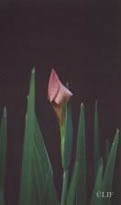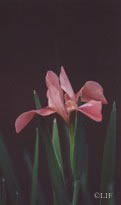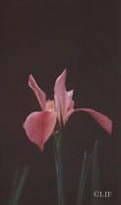Growing Irises in GULF STATES
|
|
|
 |
 |
 |
| You can grow irises. With at least a half-day
of sun, dampness during the Spring bloom season, and a heavy
summer mulch, you can have iris blooms and cut iris flowers.
The growing of Louisiana irises in a garden is easy.
The ideal location for growing Louisiana irises would be full sun with late afternoon shade, away from large trees or plants with extensive root systems, and protected from high winds. At least one-half day of sun is needed in order for the irises to bloom, and the ability to apply moisture to the area during dry periods is a necessity. The elevation of your flower bed may vary. The beds may be at least ground level, or they may be raised off the ground. Irises mix well with other annuals or small plants in regular beds. Irises may also be grown around the edge of a pond, or they may be grown in water. In choosing location and coordinating planting with other ornamentals, consider that the growing season for the iris begins in September and extends through April. During this period the foliage will grow and turn an intense green and is in sharp contrast to the otherwise dormant growth of other plants. It is particularly pleasing during the winter months. During bloom season the colors will be magnificent. However, by mid-summer, the foliage will die back (this loss will depend upon the moisture in the beds), and the sight is not as pleasant. The foliage may be cut back or you might want to plant smaller ornamental plants to block this natural process. If planting will be outside the Gulf Coast area, the growing season will begin later and bloom should be in early to mid-summer. A year round mulch is necessary and as soon as the hard freezes are over, fertilize heavily to help the growth. Louisiana irises do not have to stand in water in order to have maximum growth and bloom. Boggy conditions are not essential to success. This is a common misconception. However, the general rule is that once new growth has begun, the beds should not be allowed to dry out. During the first two weeks after planting, it is important that the beds are well watered. Since September and October are generally dry months in the Gulf Coast area, a weekly soaking is often necessary. Once the rains start and the ground stays damp, generally mid-November through February, watering should not be necessary. Thereafter, periodic checks to make sure the ground is damp is sufficient. If planted in geographical areas which are typically dry between September through April, it is very important that moisture content of the ground be maintained. Any soil suitable for azaleas and camellias will be suitable for irises. The Louisiana iris prefers an acidic soil with a pH of 6.5 or less. Organic matter is also important in growing, so mixing into the bed pine needles, compost, rotten leaves, rotten manure or peat moss will create a more natural habitat. Remember, these plants originated in alluvial deposits of the Lower Mississippi Valley, which were the richest soils in the world. If able, work the bed with a power tiller and add into the soil and compost about 10 pounds per 100 square feet of 8-8-8. If you buy bare-rooted rhizomes, just place them in water until ready to plant (the foliage should be out of the water). Plant about 1 inch below the tilled surface and plant between 12 and 24 inches apart. This will give room for the rhizomes to grow and multiply into several new plants in the following years. If plants become too crowded, they may not bloom. Cover with mulch and keep moist. Louisiana irises establish readily and multiply rapidly, but are not intrusive. The rhizome clump may need to be divided every 3 to 5 years, depending upon how closely together the rhizomes were initially planted. Each rhizome blooms only once, and the offshoots will bloom the next year. The offshoots represent next year’s bloom, and the bloom from them will be identical in every respect. You can expect at least two non-blooming offshoots per bloom each season. Problems with pests or diseases are not common. Louisiana irises grow well in water. Water planting is advantageous because it eliminates weeding. The irises may be planted on the edge of ponds, ditches, or lakes. The rhizomes should be planted in the soil of the water bottom. At least 4 inches of the foliage must extend above the water surface. (If all foliage remains under water for extended periods, the plant will die.) As the foliage grows, the water depth may be increased. Most Louisiana irises grow well in 6 inches of water, but many thrive in up to 12 to 15 inches of water. Fertilize in the fall with a soluble fertilizer and on a periodic basis from fall until spring bloom. Louisiana irises are heavy feeders, and the plant requires a lot of nutrients. What is lacking in the soil can be supplemented with fertilizer. If you are just starting a bed and have already worked in a fertilizer such as 8-8-8, then you might consider applying another dosage after fear of a hard freeze. During the late winter months, a fertilizer which lacks nitrogen, such as 0-20-20, may be beneficial. On established beds, it is recommended that the grower fertilize at the beginning of growing season and then apply a light dressing again in late February. Cover irises up with mulch. Mulching will keep the moisture in the ground and keep weeds from profusely growing. But more importantly, it will protect the rhizomes during the summer months, for direct sun causes them to rot. I recommend 2 to 4 inches of pine needles, semi-rotten leaves, bagasse or grass clippings. |
